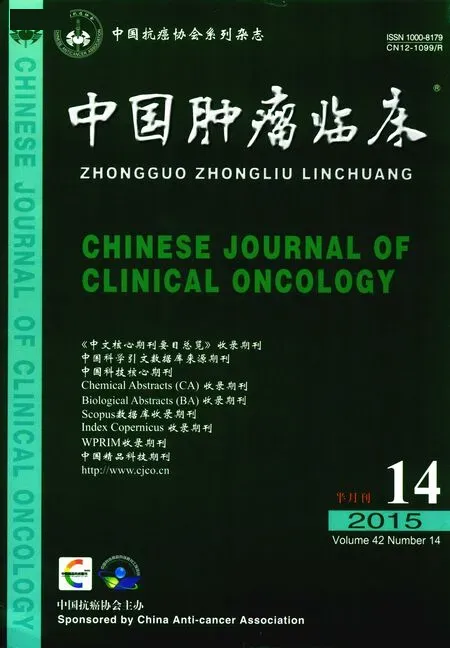Polo样激酶1在去势抵抗性前列腺癌中的研究进展*
王丽丽 综述 王海涛 审校
前列腺癌(prostate cancer,PCa)是老年男性常见的恶性肿瘤。在欧美国家男性PCa的发病率已居第1位,在美国PCa已成为男性癌症的第二大死因。2014年美国PCa的新发病例数约233 000例,死亡病例数约29 480例[1]。在我国随着生活习惯的改变、人口的老龄化及检查方法的提高,PCa的发病率呈显著增长趋势,由1998年3.52/10万到2008年11.00/10万,增长率为212.5%[2]。我国大多数PCa诊断时已处于中晚期,虽然内分泌治疗可使多数患者的病情得到控制与改善,但经过18~24个月的缓解期后,绝大多数患者都会发展为预后极差的去势抵抗性前列腺癌(castration resistant prostate cancer,CRPC),中位生存期仅为12个月[3]。目前,尽管内分泌治疗、化疗、生物治疗、冷冻治疗等多学科综合疗法可改善CRPC的疗效,但其试用范围窄、费用高、耐受差的特点使受益患者的数量有限,总生存率不容乐观。所以,仍需要寻找新的分子靶点,以提高CRPC个体化治疗的效果。近年来,越来越多的基因靶点被相继发现并用于CRPC细胞的研究,Polo样激酶1(Polo-like kinase,PLK1)就是其中的一个典型代表。有研究[4-5]表明,PLK1在CRPC细胞中高表达,且该基因的敲低或抑制可阻滞CRPC细胞的生长与增殖,有望成为治疗CRPC的新靶点。
1 PLK1的基本结构与功能
Polo样激酶(Polo-like kinases,PLKs)是一类广泛存在于真核生物中的丝氨酸/苏氨酸蛋白激酶,目前在人类细胞中存在5种亚型。各亚型的结构极其相似,均由N末端的激酶结构域、C末端的PBD结构域(polo-box domain)和中间的连接区域组成。PLKs的N端为丝氨酸/苏氨酸催化区域,含有一个T2环结构,其中Thr210残基可磷酸化而被激活;C端PBD结构域中含有Trp414残基、His538残基和Lys540残基,均可决定PLKs所结合底物的特异性[6-7]。在人类PLK家族的所有成员中,PLK1的研究最为深入。PLK1在细胞有丝分裂的多个阶段起着重要作用,包括Cdc2的活化、中心体的成熟[8]、双极纺锤体的形成、染色体的分离[9]、后期促进因子复合物的调控、细胞质分裂等。此外,PLK1还参与DNA的合成、损伤修复[10],细胞周期多个监测点的调控。近来有研究发现,PLK1与DNA依赖蛋白激酶催化亚单位(DNA-PK catalytic subunit,DNA-PKcs)协调作用可促进细胞的有丝分裂[11],且PLK1还可使异质性核糖核蛋白-U(SAF-A/hnRNP-U)丝氨酸59位点发生磷酸化[12]。相反,抑制PLK1与Aurora激酶,癌细胞不能正常进行有丝分裂[13]。
近年来,人们发现PLK1不仅参与细胞周期的调控,在哺乳动物雷帕霉素靶蛋白(mTOR)、卵母细胞减数分裂过程中也起了重要作用。Shao等[14]研究发现,PLK1可以作用于雷帕霉素不敏感蛋白复合体(mTORC2)中新的结合蛋白Rictor。另外,Solc等[15]结合特异性小分子抑制剂与小鼠卵母细胞成像发现,PLK1在卵母细胞减数分裂过程中起重要作用,包括促进核膜破裂、形成双极纺锤体、稳定着丝粒与微管附着、正确分离染色体、维持减数分裂Ⅰ~Ⅱ间隙期染色体的缩合等。Fan等[16]研究同样支持PLK1表达有助于卵母细胞发育的观点。
2 PLK1与CRPC发生、发展的关系
PLK1在正常组织中(除胎盘、脾、睾丸和卵巢外)少量表达,但在多数肿瘤中却过度表达。有研究发现,PLK1在CRPC细胞中高表达[4-5]。Reagan-Shaw等[5]在2005年比较了人类PCa细胞和正常前列腺上皮(PrEC)细胞中PLK1表达情况,免疫印迹结果显示,在LNCaP(野生型p53、去势敏感性)、DU145(突变型p53、去势难治性)、PC3(p53缺失、去势难治性)细胞中,PLK1均过表达,而在PrEC细胞中,并未检测到PLK1表达。随后采用小干扰RNA敲低PLK1表达发现,有丝分裂细胞周期阻滞、细胞质失分裂、中心粒完整性缺失,但PrEC细胞并未受到影响。Deeraksa等[4]检测了去势抵抗性 PCa细胞系(LNCaP-AI)中PLK1表达情况,结果显示PLK1在LNCaP-AI中过表达。Zhang等[17]评估了PLK1在雄激素依赖与去势抵抗PCa细胞中的作用,结果显示PLK1的高表达与肿瘤的形成密切相关。可见,PLK1在CRPC的发生、发展阶段起了重要作用。
3 抑制PLK1治疗去势抵抗性前列腺癌的研究进展
3.1 抑制PLK1对CRPC细胞产生治疗作用
在2005年,Reagan-Shaw 等[5]研究发现,敲低PLK1表达可使CRPC细胞的生长停滞于G2/M期。Strebhardt等[18]发现PLK1的小分子抑制剂可抑制CRPC细胞的生长与增殖。另外,Deeraksa等[4]研究发现,在去势情况下LNCaP-AI细胞对PLK1小分子抑制剂BI2536非常敏感,可使癌细胞凋亡坏死,而BI2536对LNCaP细胞几乎不起作用。此外,BI2636还可导致LNCaP-AI细胞的活力降低、生长抑制、有丝分裂突变、自噬通路激活。Kim等[19]经DNA微阵列分析发现,薄荷醇可下调PLK1活性,进而使PC3细胞的生长停滞于G1/M期。Lu等[20]通过斑马鱼实验与计算机筛选测试发现,PLK1小分子抑制剂可抑制小鼠移植瘤模型中PC3细胞的生长。Zhang等[17]发现,BI2536既下调了SREBP-依赖性激酶(参与雄激素合成)的表达,也抑制了CRPC移植瘤模型中肿瘤的生长。可见,抑制PLK1对CRPC细胞产生治疗作用。
3.2 抑制PLK1可增强CRPC对内分泌治疗与化疗的敏感性
近年来,CRPC患者对内分泌治疗与化疗产生的耐药问题越来越受关注。Zhang等[21]研究发现,BI2536与雄激素信号通路阻滞剂(ASI)联合可协同抑制CRPC细胞中的雄激素受体(AR)信号通路,此外BI2536可对抗MR49F细胞(对恩杂鲁胺耐药)和去势抵抗性前列腺癌移植瘤模型(LuCaP35CR)对ASI的耐药。Zhang等[17]研究同样支持抑制PLK1可抑制AR信号通路的观点。有研究报道,PLK1可使微管动力的两个重要调节因子 CLIP-170[22]和 P150Glued[23]磷酸化。Hou等[24]通过实验证实,抑制PLK1可以阻断CLIP-170和P150Glued的磷酸化,进而抑制微管蛋白的动力,增加AR蛋白的降解,减少其在核内的蓄积,促进多西紫杉醇所致的细胞凋亡。此外,Nakouzi等[25]对LZTS1低表达且对多西紫杉醇耐药的CRPC细胞使用CHK1与PLK1抑制剂后,肿瘤细胞的生长受到阻滞进而凋亡。以上研究表明,抑制PLK1可增强CRPC患者对ASI的内分泌治疗和多西紫杉醇化疗的敏感性。
3.3 抑制PLK1对CRPC细胞产生合成致死作用
近年研究发现合成致死是抗肿瘤的重要策略之一。van der Meer等[26]在PIM1过表达的PCa移植瘤模型(LNCaP、PC3)中,使用短发夹RNA(shRNA)敲低PLK1或BI2536抑制PLK1表达后,PC3-PIM1肿瘤显著缩小。此外,抑制PLK1也可降低MYC蛋白的水平,进而可能延缓肿瘤的进展。另外,Gilmartin等[27]研究发现,HES6过表达的CRPC细胞虽然对比卡鲁胺产生耐药,但对PLK1的小分子抑制剂GSK461364A仍比较敏感,可使50%以上的细胞增殖受到抑制。此外,比卡鲁胺和PLK1抑制剂联合使用可进一步减慢癌细胞的生长。近来,Ramos-Montoya等[28]研究发现,HES6在CRPC细胞中高表达,并在无配体结合的情况下,通过增强E2F1介导的细胞周期活性和AR转录活性促进CRPC细胞的生长。可见,抑制PLK1可促进PIM1过表达的CRPC细胞凋亡,也可抑制HES6过表达的CRPC细胞增殖。
3.4 联合用药对CRPC细胞产生协同抗癌效应
Wissing等[29]将 PLK1抑制剂 BI2536/BI6727和HDAC抑制剂丙戊酸钠(VPA)或伏力诺(SAHA)联合作用于CRPC细胞系(DU-145与PC3),然后通过细胞生长检测方法(MTS)与克隆形成实验分别评估细胞的增殖与存活活性。结果显示,PLK1小分子抑制剂(BI化合物)与HDAC抑制剂联合可对体外的DU-145、PC3细胞产生协同抗癌效应。另外,Shao等[30]将BI2536与二甲双胍联合作用于PCa细胞系(LNCaP、去势抵抗性的C4-2)发现,两药联合也可产生协同抑制效应。进一步的实验结果显示,联合治疗的细胞中凋亡标志蛋白-PARP降解产物的水平更高。此外,该研究还发现,联合治疗可以阻止PCa从去势敏感向去势抵抗的进展。可见,PLK1小分子抑制剂与HDAC抑制剂/二甲双胍联合用药对CRPC细胞产生协同抗癌效应。
4 结语
综上所述,PLK1可能成为CRPC分子靶向治疗的一个有效靶点,抑制PLK1可引起CRPC细胞的坏死而对正常细胞无损伤。PLK1分子靶向治疗CRPC在研究中取得了令人鼓舞的效果,体现出该治疗广阔的应用前景,但与其他治疗方式的联合应用、最佳给药方式以及剂量与安全性的关系等还有待进一步研究。总之,随着肿瘤分子机制研究的不断深入,PLK1分子靶向治疗有望提高CRPC患者个体化治疗的效果。
[1]Siegel R,Ma J,Zou Z,et al.Cancer statistics,2014[J].CA Cancer J Clin,2014,64(1):9-29.
[2]Han SJ,Zhang SW,Chen WQ,et al.Analysis of the status and trends of prostate cancer incidence in China[J].Chin Clin Oncol,2013,18(4):330-334.[韩苏军,张思维,陈万青,等.中国前列腺癌发病现状和流行趋势分析[J].临床肿瘤学杂志,2013,18(4):330-334.]
[3]Heidenreich A,Aus G,Bolla M,et al.EAU guidelines on prostate cancer[J].Eur Urol,2008,53(1):68-80.
[4]Deeraksa A,Pan J,Sha Y,et al.PLK1 is upregulated in andro⁃gen-insensitive prostate cancer cells and its inhibition leads to necroptosis[J].Oncogene,2013,32(24):2973-2983.
[5]Reagan-Shaw S,Ahmad N.Silencing of polo-like kinase(PLK)1 via siRNA causes induction of apoptosis and impairment of mi⁃tosis machinery in human prostate cancer cells: implications for the treatment of prostate cancer[J].FASEB J,2005,19(6):611-613.
[6]Archambault V,Lépine G,Kachaner D.Understanding the Polo kinase machine[J].Oncogene,2015.doi:10.1038/onc.
[7]Lowery DM,Lim D,Yaffe MB.Structure and function of Pololike kinases[J].Oncogene,2005,24(2):248-259.
[8]Kong D,Farmer V,Shukla A,et al.Centriole maturation requires regulated PLK1 activity during two consecutive cell cycles[J].J Cell Biol,2014,206(7):855-865.
[9]Park CH,Park JE,Kim TS,et al.Mammalian Polo-like Kinase 1(PLK1)promotes proper chromosome segregation by phosphory⁃lating and delocalizing the PBIP1-CENP-Q complex from kinet⁃ochores[J].J Biol Chem,2015,290(13):8569-8581.
[10]Benada J,Burdová K,Lidak T,et al.Polo-like kinase 1 inhibits DNA damage response during mitosis[J].Cell Cycle,2015,14(2):219-231.
[11]Lee KJ,Shang ZF,Lin YF,et al.The catalytic subunit of DNA-de⁃pendent protein kinase coordinated with Polo-like kinase 1 to fa⁃cilitate mitotic entry[J].Neoplasia,2015,17(4):329-338.
[12]Douglas P,Ye R,Morrice N,et al.Phosphorylation of SAF-A/hnRNP-U serine 59 by Polo-like kinase 1 is required for mitosis[J].Mol Cell Biol,2015,35(15):2699-2713.
[13]Li J,Hong MJ,Chow JP,et al.Co-inhibition of Polo-like kinase 1 and Aurora kinases promotes mitotic catastrophe[J].Oncotar⁃get,2015,6(11):9327-9340.
[14]Shao T,Liu X.Identification of rictor as a novel substrate of Po⁃lo-like kinase 1[J].Cell Cycle,2015,14(5):755-760.
[15]Solc P,Kitajima TS,Yoshida S,et al.Multiple requirements of PLK1 during mouse oocyte maturation[J].PLoS One,2015,10(2):e0116783.
[16]Fan Y,Zhao HC,Liu J,et al.Aberrant expression of maternal PLK1 and Dctn3 results in the developmental failure of human in-vivo-and in-vitro-matured oocytes[J].Sci Rep,2015,5:8192.
[17]Zhang Z,Chen L,Wang H,et al.Inhibition of PLK1 represses an⁃drogen signaling pathway in castration-resistant prostate cancer[J].Cell Cycle,2015,14(13):2142-2148.
[18]Strebhardt K,Ullrich A.Targeting Polo-like kinase 1 for cancer therapy[J].Nat Rev Cancer,2006,6(4):321-330.
[19]Kim SH,Lee S,Piccolo SR,et al.Menthol induces cell-cycle ar⁃rest in PC-3 cells by down-regulating G2/M genes,including Po⁃lo-like kinase 1[J].Biochem Biophys Res Commun,2012,422(3):436-441.
[20]Lu J,Xin S,Meng H,et al.A novel anti-tumor inhibitor identi⁃fied by virtual screen with PLK1 structure and zebrafish assay[J].PLoS One,2013,8(4):e53317.
[21]Zhang Z,Hou X,Shao C,et al.PLK1 inhibition enhances the effi⁃cacy of androgen signaling blockade in castration-resistant pros⁃tate cancer[J].Cancer Res,2014,74(22):6635-6647.
[22]Li H,Liu XS,Yang X,et al.Phosphorylation of CLIP-170 by PLK1 and CK2 promotes timely formation of kinetochore-micro⁃tubule attachments[J].EMBO J,2010,29(17):2953-2965.
[23]Li H,Liu XS,Yang X,et al.Polo-like kinase 1 phosphorylation of p150Glued facilitates nuclear envelope breakdown during pro⁃phase[J].Proc Natl Acad Sci U S A,2010,107(33):14633-14638.
[24]Hou X,Li Z,Huang W,et al.PLK1-dependent microtubule dy⁃namics promotes androgen receptor signaling in prostate cancer[J].Prostate,2013,73(12):1352-1363.
[25]Nakouzi NA,Cotteret S,Commo F,et al.Targeting CDC25C,PLK1 and CHEK1 to overcome Docetaxel resistance induced by loss of LZTS1 in prostate cancer[J].Oncotarget,2014,5(3):667-678.
[26]van der Meer R,Song HY,Park SH,et al.RNAi screen identifies a synthetic lethal interaction between PIM1 overexpression and PLK1 inhibition[J].Clin Cancer Res,2014,20(12):3211-3221.
[27]Gilmartin AG,Bleam MR,Richter MC,et al.Distinct concentra⁃tion-dependent effects of the polo-like kinase 1-specific inhibi⁃tor GSK461364A,including differential effect on apoptosis[J].Cancer Res,2009,69(17):6969-6977.
[28]Ramos-Montoya A,Lamb AD,Russell R,et al.HES6 drives a critical AR transcriptional programme to induce castration-resis⁃tant prostate cancer through activation of an E2F1-mediated cell cycle network[J].EMBO Mol Med,2014,6(5):651-661.
[29]Wissing MD,Mendonca J,Kortenhorst MS,et al.Targeting prostate cancer cell lines with polo-like kinase 1 inhibitors as a single agent and in combination with histone deacetylase inhibitors[J].FASEB J,2013,27(10):4279-4293.
[30]Shao C,Ahmad N,Hodges K,et al.Inhibition of Polo-like kinase 1(PLK1)enhances the antineoplastic activity of metformin in prostate cancer[J].J Biol Chem,2015,290(4):2024-2033.

